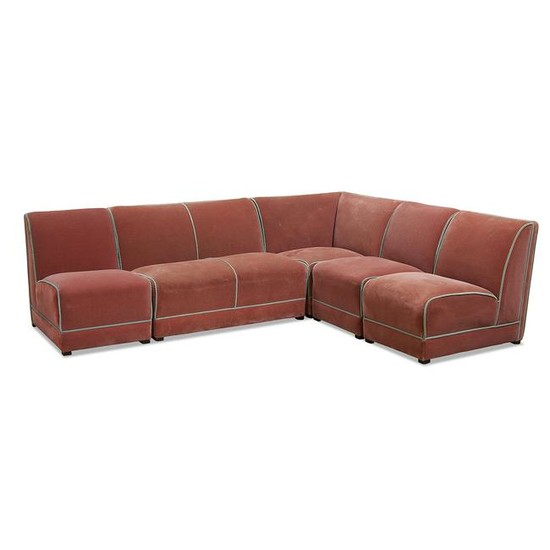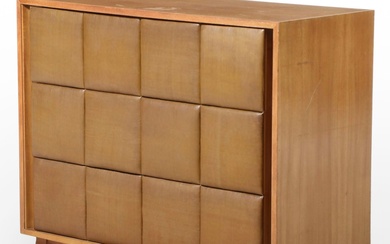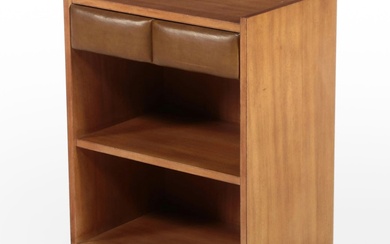Gilbert Rohde for Herman Miller Chairs, five
Gilbert Rohde (1894-1944) for Herman Miller
Combination Chairs, five pieces, #3700, #3701 and #3702
Zeeland, Michigan, circa 1934
mohair, upholstery, wood
unmarked
This set consists of one corner piece, a settee and three single chairs.
corner: 37"sq x 31"h; settee: 45"w x 35"d x 31"h; chairs (each): 24"w x 35"d x 31"h
Provenance:
The Estate of Michael Rabkin, Los Angeles, California
Catalog Note:
Rohde's Combination Chairs represented the first modular furniture system introduced to the American market, along with his important East India Laurel Group pieces. (Lots 400-406)
Condition Report: Overall good condition with slight soiling and fading from age and use. No tears or odors.
Biography: Groundbreaking designer Gilbert Rohde was born in 1894 in New York City, where he lived throughout his life. Rohde graduated from Stuyvesant High School in 1913. Further studies included instruction at the Art Students League and the Grand Central School of Art. Initially, Rohde worked as an advertising illustrator. However, tours of Europe in 1927, 1931, and 1937 fueled Rohde’s passion for design and forged his aesthetic philosophy, which combined elements of Bauhaus, French Moderne, and American Streamline Moderne. In 1927, Rohde set up a design office in New York City and began producing furniture and other items for General Electric and the Hudson Motor Car Company. Rohde created an armless leatherette side chair in 1931 using an assembly-line process for the Heywood-Wakefield Company, and over 250,000 chairs sold by the end of the decade. In 1932, Rohde was made director of design for Herman Miller Furniture Company in Zeeland, Michigan by president D.J. De Pree. Rohde’s first design for Herman Miller was the No. 2185 bedroom suite, which was shown at Chicago’s Century of Progress exhibition in 1933. As accolades mounted, Rohde helped found the Designers Institute of the American Furniture Mart in 1933, became director of the Design Laboratory School from 1935 to 1938, and led the industrial design program at the New York University School of Architecture from 1939 to 1943. Rohde also developed exhibits for the New York World’s Fair in 1939. Simultaneously, Rohde produced cutting-edge designs for Herman Miller, including the first biomorphic furniture sold widely in America. In addition to formal innovation, Rohde employed materials that were then uncommon, such as Lucite, Plexiglas, Bakelite, and Fabrikoid, a DuPont leatherette. Wielding his influence at Herman Miller, Rohde convinced the company in 1940 to stop reproducing period furniture in favor of wholly modern designs. In 1942, Rohde unveiled his Executive Office Group line with 137 configurable elements for various business environments. Although Rohde passed away in 1944, his approach continued to influence Herman Miller for years. Rohde’s designs are now sought after by collectors and his work is part of the collections of the Metropolitan Museum of Art in New York City, the Henry Ford Museum in Dearborn, Michigan, the Los Angeles County Museum of Art, and the Victoria and Albert Museum in London.
View it on
Sale price
Estimate
Time, Location
Auction House
Gilbert Rohde (1894-1944) for Herman Miller
Combination Chairs, five pieces, #3700, #3701 and #3702
Zeeland, Michigan, circa 1934
mohair, upholstery, wood
unmarked
This set consists of one corner piece, a settee and three single chairs.
corner: 37"sq x 31"h; settee: 45"w x 35"d x 31"h; chairs (each): 24"w x 35"d x 31"h
Provenance:
The Estate of Michael Rabkin, Los Angeles, California
Catalog Note:
Rohde's Combination Chairs represented the first modular furniture system introduced to the American market, along with his important East India Laurel Group pieces. (Lots 400-406)
Condition Report: Overall good condition with slight soiling and fading from age and use. No tears or odors.
Biography: Groundbreaking designer Gilbert Rohde was born in 1894 in New York City, where he lived throughout his life. Rohde graduated from Stuyvesant High School in 1913. Further studies included instruction at the Art Students League and the Grand Central School of Art. Initially, Rohde worked as an advertising illustrator. However, tours of Europe in 1927, 1931, and 1937 fueled Rohde’s passion for design and forged his aesthetic philosophy, which combined elements of Bauhaus, French Moderne, and American Streamline Moderne. In 1927, Rohde set up a design office in New York City and began producing furniture and other items for General Electric and the Hudson Motor Car Company. Rohde created an armless leatherette side chair in 1931 using an assembly-line process for the Heywood-Wakefield Company, and over 250,000 chairs sold by the end of the decade. In 1932, Rohde was made director of design for Herman Miller Furniture Company in Zeeland, Michigan by president D.J. De Pree. Rohde’s first design for Herman Miller was the No. 2185 bedroom suite, which was shown at Chicago’s Century of Progress exhibition in 1933. As accolades mounted, Rohde helped found the Designers Institute of the American Furniture Mart in 1933, became director of the Design Laboratory School from 1935 to 1938, and led the industrial design program at the New York University School of Architecture from 1939 to 1943. Rohde also developed exhibits for the New York World’s Fair in 1939. Simultaneously, Rohde produced cutting-edge designs for Herman Miller, including the first biomorphic furniture sold widely in America. In addition to formal innovation, Rohde employed materials that were then uncommon, such as Lucite, Plexiglas, Bakelite, and Fabrikoid, a DuPont leatherette. Wielding his influence at Herman Miller, Rohde convinced the company in 1940 to stop reproducing period furniture in favor of wholly modern designs. In 1942, Rohde unveiled his Executive Office Group line with 137 configurable elements for various business environments. Although Rohde passed away in 1944, his approach continued to influence Herman Miller for years. Rohde’s designs are now sought after by collectors and his work is part of the collections of the Metropolitan Museum of Art in New York City, the Henry Ford Museum in Dearborn, Michigan, the Los Angeles County Museum of Art, and the Victoria and Albert Museum in London.





